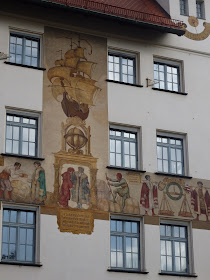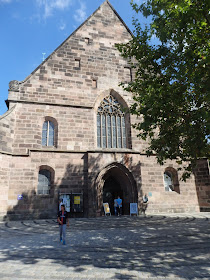 |
| Heading into Nuremberg, we slide into the Eibach lock. At 65.6' it was the deepest one that I was on deck for the transit. This is lock #23 of the 66 we will go through during the trip. |
 |
| These are the water reservoirs. Most of the water for each transit is reused and stored in these huge reservoirs. |
 |
| Here's the Captain working hard to get the ship positioned in the lock. |
 |
| Ship's crew hard at work maintaining the ships position. |
 |
| There are bumpers alongside the ship to keep it from scraping on the lock sides. |
 |
| We are sinking fast! |
 |
| I'm standing on the lower part of the Skydeck looking back towards the upper Skydeck. Notice that everything is laid down on the upper deck. |
 |
| The lock door sliding upwards... |
 |
| Time to start moving forward. |
 |
| That hole doesn't look big enough for us. |
 |
| Time to get dripped on. The ship's personnel were constantly cleaning the ship's exterior. |
 |
| The Captain had lowered the wheelhouse to fit under the lock door. But wait? We just went under the road instead of above it. That was a deep lock. |
 |
| Wheelhouse rising and semi crossing the bridge we just went under |
 |
| Occasionally we would see phones alongside the canal. |
 |
| Out front the navigation arm had also been lowered. Here it is starting to rise. |
 |
| Navigation arm fully up into position |
 |
| This photo is blurry because it was taken out the window of a bus as we headed into Nuremberg. This was the largest semi combo I saw during our trip. |
 |
| The bus took the road under this underpass. The bus is 3.2 meter high. |
 |
| Nuremberg has a huge rail yard. |
 |
| Notice the sign and how the car is parked. Yes, they park up on the sidewalk. Other places I saw that they were parked half on the road and half on the sidewalk. Interesting. |
 |
| Construction begin on the Congress Hall in 1935 but it was never finished. It is 128' tall with a diameter of 820'. |
 |
| One of the buildings at the "foot" of the Congress Hall has served as the Nazi Party Documentation Center since 2001 while the other "foot" houses the Nuremberg Symphony Orchestra. |
 |
| Our next stop was the Zeppelin Field. This area, with a huge grandstand, was the site of large gatherings of the Nazi Party. |
 |
| Due to deterioration, most of the Nazi era structures have been demolished. These piers supported seating. |
 |
| Back side of the piers. |
 |
| Details on the building in the previous photo. This building is just to the east of the part of the Palace of Justice where the trials of 24 men took place from November 1945 to October1946. |
 |
This is the Rose Cemetery where lots of famous people from Nuremberg's history are buried. It is called the Rose Cemetery because of the many rosebushes it contains. |
 |
| German UPS truck |
 |
| The bus dropped us off in the oldest part of Nuremberg. This interesting building is at the corner of Waaggasse and Hauptmarkt. |
 |
| The murals were interesting and I bet they portrayed some of the history of Nuremberg. |
 |
| The old part of Nuremberg had a wall all the way around it. You can see it in a few pictures later on in this post. |
 |
| Old Town Hall by St. Sebald Church |
 |
| One of the decorative entrances to the Old Town Hall |
 |
| St Sebald church |
 |
| Sculptured part of one of the church's columns. |
 |
| Back of St Sebald Church |
 |
| City Museum |
 |
| Nasty! |
 |
| From close to the castle looking back down past the old Town Hall. |
 |
| Looking up at the Imperial Castle. You can see it is built on rock. |
 |
| Still looking up at the castle |
 |
| Heading down the hill to the southwest of the Castle |
 |
| Plaza along the old city walls. House in the middle back was the home of Albrecht Durer, painter and printmaker of the German Renaissance |
 |
| Well in the plaza |
 |
| One of the towers in the wall. |
 |
| Portal to path through the old town wall. |
 |
| Headed south on Albrecht Durer Street. |
 |
| I think this street is Agnesgasse. |
 |
| Sidetracking down pretty streets got me a little lost for short time. |
 |
| Fountain in Maxplatz. From the east edge of Maxplatz, I saw the Maxbruche (Max Bridge) and realized I was further south than I needed to be. |
 |
| The Wochenmarkt takes place at Hauptmarkt Mondays thru Saturday. Here visitors and locals can stock up on all sorts of fresh vegetables, fruits, eggs and dairy products from local farmers. |
 |
| Back to Frauenkirche. This is a photo of the lower part where you can see some of the fabulous decorations. You might have to click to enlarge to see the figures on the corners. |
 |
| This brick gothic style is really different. |
 |
| Back on the ship for lunch, dessert was Black Forest Cake with fruit garnish. The presentation of all the food was this pretty. |
 |
| Afternoon found my sister and I back in Old Town Nuremberg. This is Spittletor Tower, an defensive tower on the old town wall. |
 |
| Kirche St. Jakob |
 |
| Inside of Kirche St. Jakob |
 |
| St. Elizabethkirche - St Elizabeth's Church |
 |
| More of Ehkarussell. Completed in 1981, the fountain was put in place to cover an air shaft from the metro. |
 |
| Next we walked to the Hangman's Bridge |
 |
| From Hangman's Bridge we could see Maxbruche (Max Bridge). Looks decorative but our bus had crossed it earlier in the day. |
 |
| This picturesque place is the former home of the town's official executioner. |
 |
| Yes Hangman's Bridge leads to the Executioner's house. |
 |
| Just loved this beautiful view. |
 |
| Looking the other way off Maxbruche, we could see the water dropping off a ledge before proceeding under Kettensteg, the oldest suspension bridge in Germany, and part of the defensive wall. |
 |
| Going over the Museum Bridge |
 |
| St. Lawrence Church |
 |
| Back on the ship leaving Nuremberg, we immediately go through another lock. This is Nuremberg lock with a drop of 30.83'. We are leaving the lock in this photo. Notice the bicyclists on the bridge. |
 |
| Lowered wheelhouse with the Captain looking out the top. |
 |
| Close up of the top of the TV tower. |
 |
| A pyramid in Germany. Don't know what it housed. |



























No comments:
Post a Comment